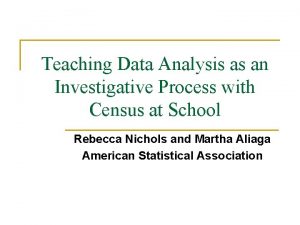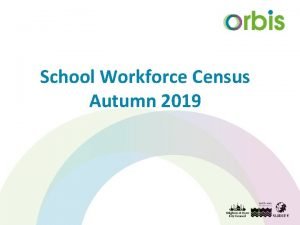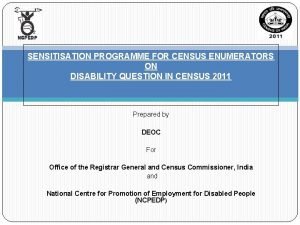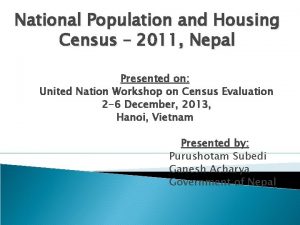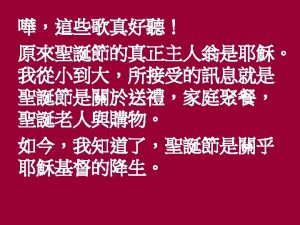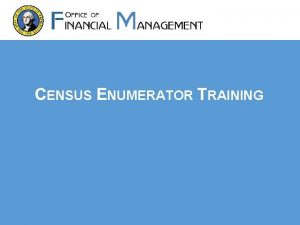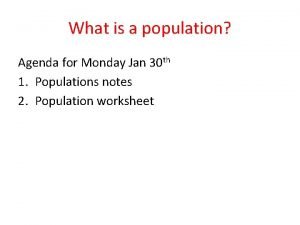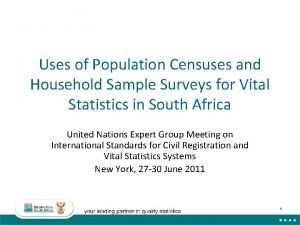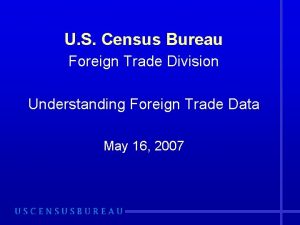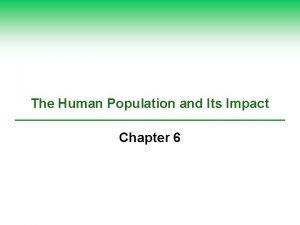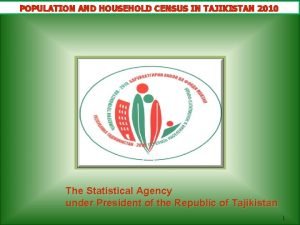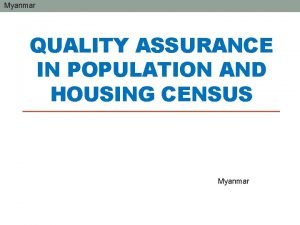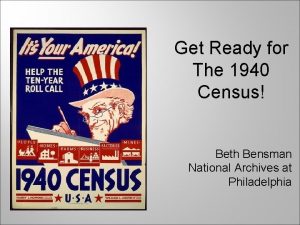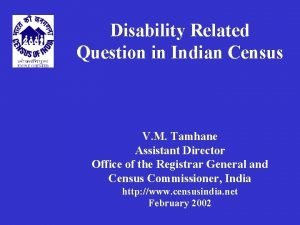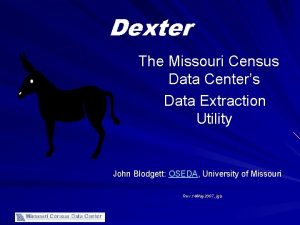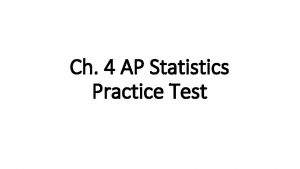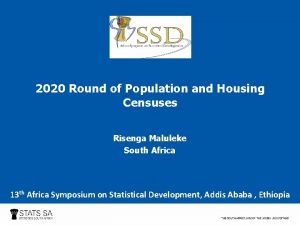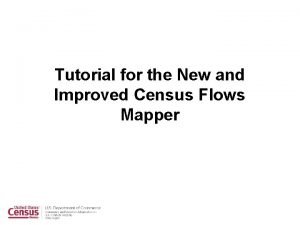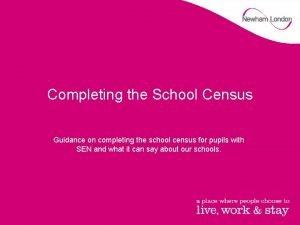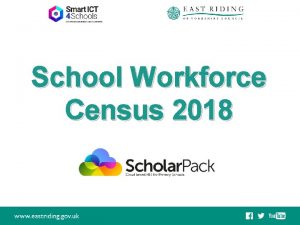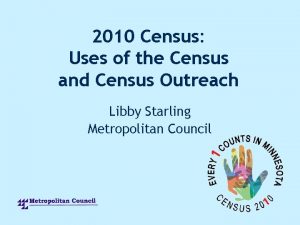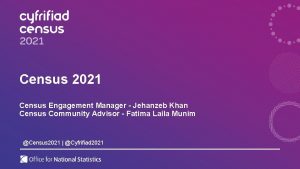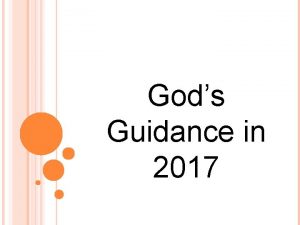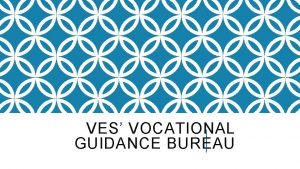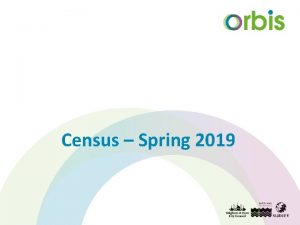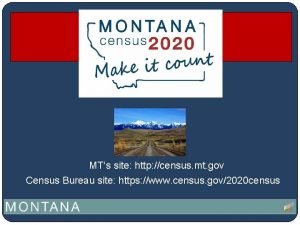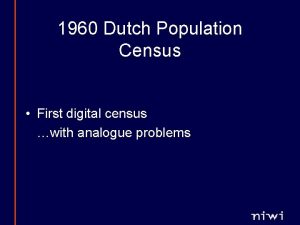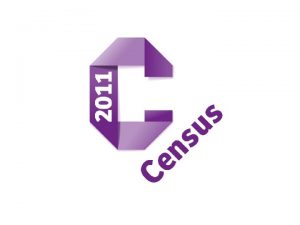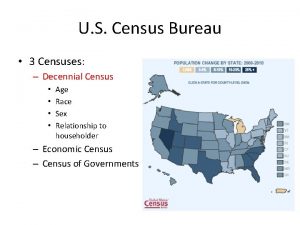Completing the School Census Guidance on completing the





















- Slides: 21

Completing the School Census Guidance on completing the school census for pupils with SEN and what it can say about our schools.

Identification of SEN • SEN Code of Practice 0 -25 Schools will have clear process for identifying SEN and not conflating it with poor progression as there will be a clear focus on high quality teaching for all (Co. P 6. 4) • Probable Focus of a Local Area Inspection How effectively does the local area identify children and young people who are disabled and/or have special educational needs? Slide 2

School Census 2015 • The DFE have published a new guide to the school census which incorporates changes to census information required by the new SEN Code of Practice (2014). • SIMS has been automatically updated to take account of these changes and allow SEN provision information to be collected in accordance with the new requirements. Slide 3

https: //www. gov. uk/government/publications/school-census-2015 -to-2016 -guide-for-schools-and-las Slide 4

Transitional Period until April 2018 • During the transitional period schools will be able to record pupils as having either ‘S’ statement or ‘E’ - EHC plan in SIMS. • Schools may have some pupils with statements and some who have already moved to EHC plans but no individual pupil can have both Slide 5

• SEN information will be collected in the census collections for all pupils on roll on census day. • SEN provision at the time of any exclusion will also be collected in all school census collections. • (This could include SA or SAP if they were excluded before January 2015) Slide 6

Until April 2016 Code N Description No special educational need S E Statement (until 2016) Education, health and care plan K SEN support Slide 7

After April 2016 Education, Health and Care Plan E SEN Support K Slide 8

School Action Early Years Action School Action Plus Early Years Action Plus SEN Support Slide 9 K

4. 5. 2 Pupil SEN type ranking • A pupil’s special educational need is recorded in pupil SEN type • The most significant, or primary need, is ranked as • Any secondary need is ranked as • If there is more than one SEN need reported they cannot both have a ranking of Slide 10

Code Description SPLD MLD SLD PMLD SEMH SLCN HI VI MSI PD ASD OTH NSA Specific learning difficulty Moderate learning difficulty Severe learning difficulty Profound & multiple learning difficulty Social, emotional and mental health Speech, language and communication needs Hearing impairment Visual impairment Multi-sensory impairment Physical disability Autistic spectrum disorder Other difficulty / disorder SEN support but no specialist assessment of type of need Slide 11

4. 5. 5 Member of resourced provision indicator • This indicator identifies pupils who receive support for their type of SEN from a specialist resourced provision. • This data item is collected in the spring census only for all pupils on roll on census day with: • ‘E’ (education, health and care (EHC) plan) or • ‘S’ (statement) • ‘K’ (SEN support) Slide 12

MLD - definition Pupils with MLD will have attainments well below expected levels in all or most areas of the curriculum, despite appropriate interventions. They will have much greater difficulty than their peers in acquiring basic literacy and numeracy skills and in understanding concepts. They may also have associated speech and language delay, low self-esteem, low levels of concentration and underdeveloped social skills. Slide 13

pupils with MLD may need support with • understanding instructions and the requirements of tasks • acquiring sequencing skills − for example, when following a recipe or science experiment • understanding how they affect and relate to their immediate surroundings • personal organisation over the short, medium and long term • visual and auditory memory for information, processes and instructions. • Plus careful assessment of baselines and monitoring of progress to ensure that their progress can be recognised and built upon. These look a lot like aspects of Quality First Teaching… so what defines a pupil as MLD in your school? Slide 14

Pupils on the SEN register • have an identified need • receive individualised, specialist and targeted provision Slide 15

Principles of Best Practice • Reviewing the register should be an ongoing process • It is an integral part of the assess/plan/do/review cycle and the graduated approach • Provision should be reviewed in the light of evidence gathered related to pupil progress • The register should be ‘fluid’. Slide 16

Assess Plan Initial Concern Form Provision map Assessment information Individual timetable/ personalised programme Observations Planned long term and short term targets Multi-agency advice Teacher’s planning Parents and pupil views Support plan/statement /EHC plan Do Review Books or multi media evidence School reports Records of interventions and support Assessments data Feedback report/liaison between teachers and TA IEP (or similar) reviews Feedback from teacher to pupil Records of pupil progress meeting observations Completed Annual Review papers Progress data Slide 17

Principles of Best Practice • A strong foundation of universal high quality teaching • Good use of notional SEN budgets and pupil premium • Should lead to a reduction in the number of pupils who need to access targeted and specialist provision Slide 18

Where pupils are receiving high quality provision but progress is still a concern…. Assessment to identify gaps in learning or areas for development Plan evidence based interventions Track progress Evaluate the impact of the provision Slide 19

SEN clearly identified through a graduated approach SEN Support Established/identified learning difficulty Slide 20

Specialist individualised provision for a few Targeted provision for some Universal provision for all Slide 21
 Incisal guidance angle value
Incisal guidance angle value Developing guidance skills direct and indirect guidance
Developing guidance skills direct and indirect guidance Quantitative variable examples
Quantitative variable examples School workforce census 2017
School workforce census 2017 School workforce census 2019
School workforce census 2019 Census disability question
Census disability question National population and housing census 2011
National population and housing census 2011 Caesar augustus issued a decree that a census
Caesar augustus issued a decree that a census Our census our future
Our census our future Census enumerator training
Census enumerator training Http://www.census.gov/popclock/
Http://www.census.gov/popclock/ Sample or census
Sample or census Foreign trade division us census bureau
Foreign trade division us census bureau Http://www.census.gov/popclock/
Http://www.census.gov/popclock/ Census definition
Census definition Www.dop.gov.mm http //myanmar.unfpa.org/census
Www.dop.gov.mm http //myanmar.unfpa.org/census 1940 census.archives.gov
1940 census.archives.gov Census disability question
Census disability question Missouri census data center
Missouri census data center Ap stats practice test multiple choice
Ap stats practice test multiple choice Gif unpacking in census
Gif unpacking in census Census flows mapper
Census flows mapper


